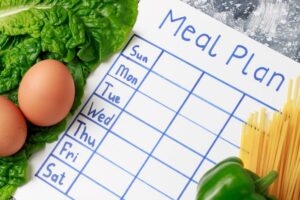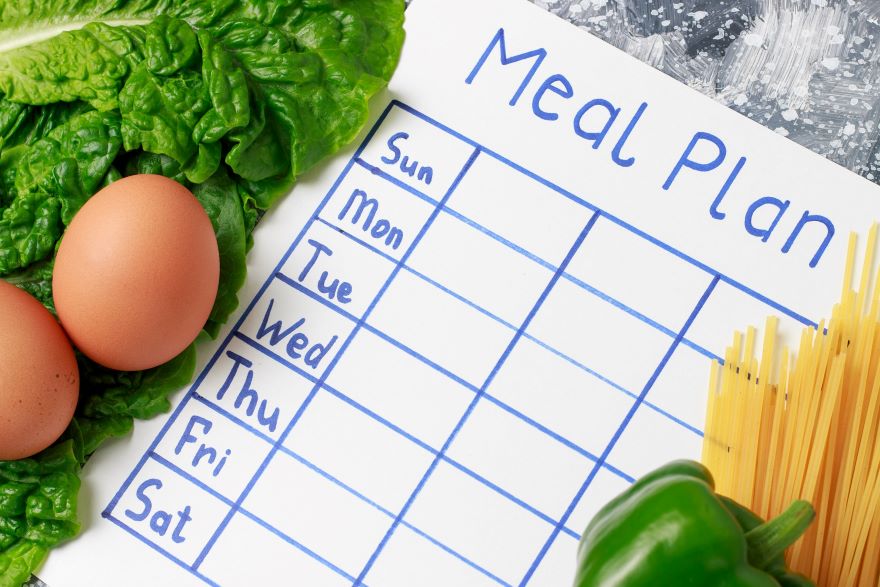Embarking on a journey to improve metabolism and achieve weight loss goals can be a bewildering challenge, but by adopting strategic meal plans like the MetaBoost Connection 7 day meal plan, the path becomes clearer and more manageable. This meal plan revitalizes your metabolic rate, optimizing weight loss efforts with a structured dietary regimen. It focuses on what, when, and how you eat, offering a multi-faceted approach to a healthier lifestyle.

My exploration into the MetaBoost Connection meal plan revealed a carefully crafted system that works to not only stimulate the body’s natural metabolic processes but also provides a variety of meals and recipes. The incorporation of foods that naturally ignite the metabolic rate is key in this plan. It ensures that each meal acts as a step toward a more efficient metabolic function, all the while aligning with individual weight loss ambitions. The meal plan also takes into consideration lifestyle integration and maintenance, allowing for a sustainable approach to managing dietary habits beyond the initial 7-day period.
Key Takeaways
- A tailored meal plan that aims to enhance metabolic processes can be essential for effective weight loss.
- The MetaBoost 7 day meal plan offers structured nutrition with meals designed to stimulate metabolism.
- Long-term lifestyle integration is fundamental to maintaining the benefits of the MetaBoost meal plan.
Understanding MetaBoost 7 Day Meal Plan

When I approach the MetaBoost 7 Day Meal Plan, as part of the larger MetaBoost Connection system, it’s clear that it focuses on optimizing metabolism, especially for women over 40. This plan incorporates specific foods and exercises to balance hormones and reduce inflammation, enhancing metabolic health effectively.
The meal plans within this system emphasize incorporating nut butters and berries due to their nutrient-dense profiles. Nut butters are a great source of healthy fats and protein, while berries are low in calories but rich in antioxidants and vitamins. Both are integral in a meal planning strategy that aims to boost metabolism.
Incorporating intermittent fasting strategies can further enhance metabolic health, as some research suggests this approach can lead to weight loss, although more studies are needed to understand its impact on cardiovascular risk factors. The MetaBoost meal plan can be adapted to include intermittent fasting in a way that suits individual lifestyles (Intermittent fasting for the prevention of cardiovascular disease).
A typical day on the MetaBoost meal plan might include:
- Breakfast: Berry smoothie with a scoop of nut butter
- Lunch: Salad with mixed greens, berries, and a protein source
- Snack: A handful of nuts and berries
- Dinner: Nutrient-rich dinner emphasizing vegetables and lean protein
By following the MetaBoost 7 Day Meal Plan, I can focus on meals that are not only delicious but also cater to metabolic needs, which is essential for effective weight management and overall health.
Benefits of the MetaBoost Meal Plan

The MetaBoost Meal Plan is designed to align with weight loss goals by emphasizing a hormonal balance through nutrient-rich foods. My experience with plans like MetaBoost highlights the potential for increased metabolism, which is crucial for shedding those extra pounds efficiently. This meal plan strategically includes healthy fats, fiber, and protein, components that not only promote a feeling of fullness but also fuel my body for the day ahead.
- Healthy Fats: Incorporating these into my meals, such as avocados and nuts, supports my hormone health and provides sustained energy.
- Fiber: Abundant in vegetables and whole grains, fiber aids in digestion and helps maintain a consistent metabolic rate.
- Protein: It’s essential for muscle repair and also plays a role in boosting metabolism. Consuming lean meats, legumes, and dairy as part of my meal plan ensures I meet my protein needs.
Adopting the MetaBoost Meal Plan can enhance vitality, making me feel more energetic throughout my day. Whether it’s tackling a workout or getting through a busy afternoon, the targeted nutrients in this meal plan are instrumental in keeping energy levels high.
Moreover, the uniformity in diet, such as the one detailed in the study about gut microbiomes and metabolomes, can influence the gut’s health—potentially leading to improved overall well-being when consistent dietary patterns like those in MetaBoost are followed.
By carefully crafting meals with these benefits in mind, I notice I can stick to my weight loss journey with greater ease, supported by a diet that fuels my body optimally and keeps me feeling satisfied.
Risks and Considerations

When considering a MetaBoost 7-day meal plan, my focus on diet should align with my current health status and nutritional needs. A high-protein, plant-based diet supports resistance training adaptations, which is beneficial for those incorporating physical activity into their lifestyle. However, individuals with specific health conditions, such as those related to thyroid health, may need to consult a healthcare provider as dietary shifts can impact thyroid function.
Stress management is also crucial. Dietary changes can influence cortisol levels, potentially affecting overall well-being. Mitigating stress through mindful eating practices is as important as the food choices themselves.
With a high-protein diet, it’s key to consider longevity and sustainability. Adopting dietary habits that improve my health outcomes while also considering the environment is critical. Balancing diet quality with ecological considerations is a growing interest; it is not just about the here and now, but also about the future.
Lastly, any diet, including the MetaBoost plan, requires careful thought about nutritional diversity. Ensuring I consume a variety of nutrients helps maintain a balanced diet and supports overall health.
My table for a quick reference:
| Entity | Consideration |
|---|---|
| Diet | Align with health & nutritional needs |
| Stress | Manage through mindful eating practices |
| Thyroid Health | Consult healthcare provider if necessary |
| Physical Activity | Consider protein needs for recovery |
In summary, while embracing a high-protein plant-based diet may be beneficial for many, I need to consider my unique health circumstances and the broader impact of my food choices, striving for a diet that promotes health outcomes and is sustainable for the planet.
MetaBoost Meals and Recipes
In my experience, the MetaBoost meal plan focuses on incorporating nutrient-dense foods that aid in boosting metabolism and promoting hormonal balance, particularly beneficial for women over the age of 40. Central to this plan are salmon, avocado, chicken, a variety of vegetables, leafy greens, olive oil, and whole grains.
Here’s what a day might look like:
- Breakfast: For a protein-packed start, I enjoy grilling a salmon fillet, rich in omega-3 fatty acids, and serving it with a side of avocado slices— a fantastic source of healthy fats.
| Meal Time | Recipe | Main Ingredients |
|---|---|---|
| Breakfast | Grilled Salmon | Salmon, avocado |
| Lunch | Chicken Salad | Chicken, leafy greens |
| Dinner | Quinoa Vegetable Mix | Quinoa, mixed vegetables |
- Lunch: My go-to is a chicken salad tossed with crisp leafy greens dressed in a homemade olive oil vinaigrette, providing a balanced blend of lean protein and essential nutrients.
- Dinner: To end the day, I prefer creating a hearty mix of whole grains such as quinoa combined with a medley of vegetables, which supports digestive health and ensures sustained energy release.
I make sure to include recipes that are easy to prepare and customize according to personal taste preferences. For anyone looking to follow the MetaBoost meal plan, it’s important to focus on fresh, unprocessed ingredients to obtain the best results.
Creating Your Meal Plan

When designing a MetaBoost 7-day meal plan, I focus on including foods that are renowned for facilitating a metabolic boost. My aim is to incorporate a balance of protein, fiber, and carbohydrates to keep calories in check while fueling my body with the necessary energy for the day.
For breakfast, eggs are my go-to choice due to their high protein content. I pair them with a source of fiber like whole-grain toast or a serving of mixed berries.
Here’s a sample day within my meal plan:
Breakfast:
- 2 boiled eggs
- 1 slice whole-grain toast
- 1 cup mixed berries
Lunch:
- Grilled chicken salad with a variety of greens
- 1 tablespoon olive oil dressing
- 1 small apple
Dinner:
- Baked salmon filet
- Steamed asparagus and carrots
- 1/2 cup cooked quinoa
Snacks:
- A handful of almonds
- Greek yogurt with a tablespoon of flaxseeds
Each meal and snack is arranged to maintain a balance between satisfaction and the strategic calorie intake that’s important for boosting metabolism. My meal plan also features the MetaBoost Fat Flush, which typically includes specific foods known to support liver function and increase fat metabolism, like leafy greens and cruciferous vegetables.
The emphasis is made on whole foods and the minimization of processed items. By sticking to this structure, I ensure a consistent intake of essential nutrients that support a healthy metabolism and contribute to overall wellness.
Lifestyle Integration and Maintenance

Integrating the MetaBoost meal plan into my lifestyle involves consistent behavioral modifications. I recognize that to maintain a positive change, I need to adopt new habits gradually. Here’s how I successfully incorporate the MetaBoost principles into my daily life:
- Hydration: I ensure to drink plenty of water throughout the day. My goal is usually around eight glasses, which keeps me hydrated and supports my metabolism.
- Sleep: Prioritizing seven to eight hours of quality sleep each night is a game changer. Good sleep is foundational for effective metabolic function and overall well-being.
Exercise Regimen:
Maintaining regular physical activity is crucial. I follow the recommended workouts that complement the MetaBoost meal plan:
- Monday/Wednesday/Friday: Strength training for muscle building.
- Tuesday/Thursday: Cardio exercises for heart health.
- Weekends: Active rest days with light activities like walking or yoga.
Stress Management:
I actively incorporate stress-reduction techniques into my routine:
- Meditation: Daily sessions help calm my mind.
- Breathing Exercises: Useful for immediate stress relief.
Behavioral Modifications:
For long-term success, I make small, sustainable changes:
- Mindful Eating: Paying attention to hunger cues.
- Portion Control: Keeping meal sizes in check.
By focusing on these aspects, I equip myself with the tools necessary to keep my metabolism boosted and maintain the positive outcomes achieved from the MetaBoost meal plan. I continually remind myself that consistency is key to integrating these changes into a permanent lifestyle that I can confidently maintain over time.
Frequently Asked Questions

In this section, I aim to address the most common inquiries about the MetaBoost 7-day meal plan, ensuring that you have a clear understanding of what it involves and how you can make the most of it for your health and weight loss goals.
What are the key components of the MetaBoost meal plan?
The MetaBoost meal plan is designed using specific foods that aim to increase your metabolism. These foods, combined with a structured eating strategy, are intended to help you lose weight effectively.
How can one obtain a free version of the Metaboost 7-day meal plan?
You can sign up for the MetaBoost program on the Svelte Training website. After signing up, you’ll have the opportunity to download the meal plan without cost.
What foods are included in the list of metabolic superfoods?
While I don’t have the exact list of foods available in the MetaBoost meal plan, it typically includes items known to support a healthy metabolism such as lean proteins, fibrous vegetables, and certain fruits.
How can I create a 7-day diet chart to enhance my metabolism?
Creating a 7-day diet chart that enhances metabolism involves selecting foods that boost metabolic rate and structuring your meals to include a balance of protein, fiber, and healthy fats. The focus is on whole foods known for their metabolic benefits.
What is the recommended breakfast to kickstart metabolic activity?
A breakfast rich in protein and fiber is generally recommended to kickstart your metabolism. It might include options such as eggs with spinach and avocados, which provide a good balance of nutrients to start the day.
Are there any variations of the MetaBoost meal plan for shorter durations, like a 3-day plan?
The program is a 7-day plan, but there may be shorter variations that can cater to different needs. For specific variants like a 3-day plan, check the official resources provided by Svelte Training.

*We may earn a commission for purchases made using our links. Please see our disclosure to learn more.



